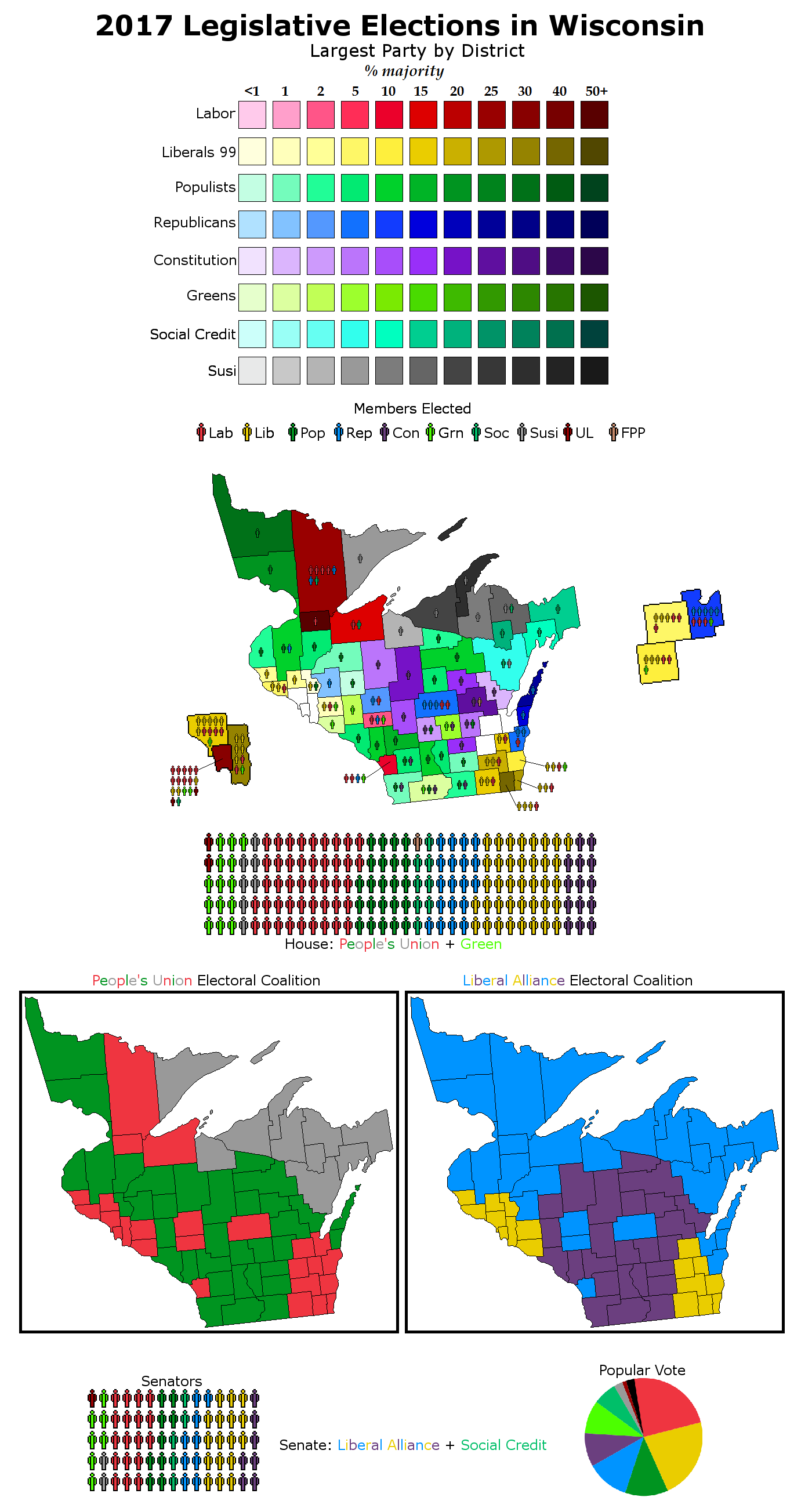The Seventh Party System: Part XXXI
Map of the United States
Part I - Metropotamia
Part II - Alta California
Part III - North Carolina
Part IV - New Jersey
Part V - Adams
Part VI - Alabama
Part VII - Rhode Island
Part VIII - Sequoyah
Part IX - Assenisipia
Part X - East Florida
Part XI - Tennessee
Part XII - Kansas
Part XIII - Dakota
Part XIV - Arizona
Part XV - Delaware
Part XVI - Oregon
Part XVII - Ozark
Part XVIII - New Hampshire
Part XIX - Western Connecticut
Part XX - New York
Part XXI - Santo Domingo
Part XXII - South Carolina
Part XXIII - Baja California
Part XXIV - Chersonesus
Part XXV - Canal Zone Territory
Part XXVI - West Florida
Part XXVII - Missouri
Part XXVIII - Colorado
Part XXIX - Trinidad and Tobago
Part XXX - Pennsylvania
Wisconsin has always been an odd state, influenced by Northern European traditions, and full of many divisions which has made it a hotbed of political parties.
Having been a battleground state between the Republicans and the Socialists for most of the late 1800s and early 1900s the state of Wisconsin had always been a center of politics which has lead to its populace being far more active than most of its counterparts, with turnouts of upwards of 80% not being uncommon for the state. The state has also been a state of many contradictions, being known for both its left leaning Scandinavians and more fiscally conservative Germans which has lead to the state large numbers of right and left wing activists. Despite this existence of a large right wing population, however, ever since the 1930s the state has been a left leaning state and even after the Conservative Revolution the left managed to reorganize itself and form the People's Union to take back the Wisconsin state legislature in 1980.
The People's Union, was originally formed as an union between Labor and a small party for ethnic Finns called Sisu. However, what started as just a temporary alliance turned into a blooming relationship as Sisu's progressive policies began to influence the Labor and was instrumental in establishing the large welfare apparatus of Wisconsin. The People's Union also established one of the first fully proportionate senates in the USA in 1988, due to both the lobbying of urban labor unions as well as the pragmatical concern of fending off advances from more rural based parties such as the Populists and Constitutionists.
However the People's Union began to face issues after the rise of the Liberals 99. The Liberals 99 are a political party and social movement lead by Scott Ryan, a devout Objectivist who pushed heavily for the abolition of all state taxes and who blamed costly pensions for the stagnating Wisconsin economy in the late 1990s. With Wisconsin having the highest income per capita of any Midwestern state Ryan found large popular support for his radical policies from middle and upper class youthful Wisconsinites who believed that bringing about "pure capitalism" would lead them to prosperity. When the Liberals managed to get 18 House seats in 2004 and the People's Union only got a total of 77 seats, the People's Union was forced to look for another partner which could support its government. The result was allying with the Populists, the only left of center party with enough seats to put them over the line, though the Populists were able to extract some heavy concessions from the People's Union as a result.
While the People's Union intended for the alliance of 04 to be just a temporary one, it soon became permanent as their partnership stretched into 2006 too as the Liberals gained 9 more seats and eclipsed the Republican party. Finally in 2008 the Liberals managed to gain enough seats to seize victory, ushering in the first right wing government of Wisconsin's history in over 30 years. However this right wing government would be short-lived, as the Liberals reigned only through a coalition with the Republicans which soon fell apart after the Republicans blocked the Liberals' plan to abolish state pensions, leading to an early election in 2009. This time the People's Union would make sure to not lose, and with the Second Great Depression having just began, the PU managed to win with flying colors.
Nevertheless, the Liberals would not stand idly by, blaming their loss on the treachery of the moderate Republicans and deciding to join forces with the Constitution party who also believed in the abolition of state taxes, albeit for different reasons. Together they formed the Liberal Alliance, named so due to their shared desire for economic liberalism. And eventually after a leadership challenge led to the dedicated fiscal conservative Ron Johnson being elected Republican party leader in 2011 the Liberal Alliance was expanded to include all three major right wing parties.
With the right wing continuing to rise as the Second Great Depression persisted on and on, the race for the Premier's House intensified as both sides poured tens of millions of dollars into the state in a bid to win the election. In the end the result astounded both sides as the People's Union won a plurality in the House and the Liberal Alliance won a plurality in the Senate. Not only did an unexpected surge in dissatisfied third party voters surprise pollsters, but also the fact that the two chambers of the legislature went to opposite sides. With the Greens predictably allying with the People's Union in exchange for a leftward shift in policy while Social Credit sided with the Liberal Alliance to spite the establishment the two legislative bodies of Wisconsin were divided for the first time since the Conservative Revolution.
While the Premiership of Wisconsin requires only a majority in the House the Senate of Wisconsin was purposefully designed to be just as strong as many Republican senates are, as the People's Union had hoped to use that body as a redoubt in case of a right wing victory. Yet this very design now put the right wing of Wisconsin in the perfect position to instead obstruct the social democratic Premier, and considering how the Liberals 99 have never passed a single bill in their entire party history, due to Scott Ryan's refusal to collaborate with the "freedom hating" People's Union the Liberal Alliance's dream of having a do nothing government at least for now have been realized.
Government:
People's Union - The eternal ruling coalition of Wisconsin since 1980, the party supports a large welfare system that is even further left than mainstream Labor's policies, however socially they have lagged behind due to the conservative influences of the Populist party.
- Labor: The main left wing party of Wisconsin, they are further to the left than the national Labor party though they have started to trend back to the norm in recent years as a reaction to the rise of the ultra right wing Liberals. Due to the large number of labor unions in the state, the party's base remains typical of most Midwestern Labor parties, that of older working class men and women. Despite the parties best efforts to try and convince young people that Wisconsin's current success was built off the backs of strong unions the vast majority of Millennials still believe unions to be the source of all corruption and vote for either the Green party or the Liberals 99.
- Populists: While nowhere near as popular as their sister party in Mississippi they still remain a strong force among rural workers and farmers who want an economically leftist and socially conservative government.
- Sisu: A party for Finns, their dedication towards the building of Wisconsin's great welfare state has made them a crucial part of the People's Union.
Greens - The main left wing opposition to the People's Union they are composed of a coalition of poorer young voters and anti establishment social democrats. Their members resent the People's Union's shift towards social conservatism following the election of 2004 and wish for the People's Union to start having more socially liberal policies, such as a legalization of gay marriage and marijuana.
Opposition:
Liberal Alliance - An alliance of economically liberal parties, the social positions of its members varies widely yet they are still united in by a fervent desire to cut taxes and abolition the welfare state that the People's Union has built up in the past 30 years.
- Liberals 99: The main right wing party in Wisconsin, they are an Objectivist party which believes that self interest is a virtue and that laissez-faire capitalism is the way of the future. The party is extremely popular among younger sections of the middle and upper class who back a capitalist "revolution" to overthrow Wisconsin's old "socialist" government. While most parties have denounced them in the past for being a "Cult of Capitalism" they have gradually gained legitimacy as their movement continues to attract anti establishment right wingers. The party is also very adamant in their claim that they are not the same as Libertarians and call the National Libertarian party revisionist capitalists, claiming that their tolerance of drugs and homosexuality betrays their "primitive and New Leftist ways."
- Republicans: The most moderate party of the Liberal Alliance, their values are still far more right wing than that of the average Republican nationwide. Arguing for an abolition of the pension, an across the board reduction of taxes, and the removal of all unemployment benefits their positions has earned them the criticism of the national Republican party, however the Establishment remains hesitant to banish them since doing so would only lead to the Liberals gaining even more strength.
- Constitution: The number one representative of the religious right, some of their members continue to hold doubts over the Liberals' affinity towards atheism and how their stated policy on religion is that it is "extremely detrimental to human life," however the party leaders have convinced their constituents that the alliance is merely for tax cuts, nothing more and nothing less.
Social Credit - Mainly concentrated among the non-Finnish population of Northeastern Wisconsin their ideals of an anti globalist and religious righteous party for the working class has continued to grow with every closed factory and shut down mine.
United Left - A catch all party for socialists and communists in Wisconsin they remain a minor force outside of the St Paul metropolitan area.
First People's Party - The centrist party for Native American interests their single seat represents the populous Menominee Reservation in parliament, but owing to their small size most of the time they remain just as ignored as the United Left.
Credit for the basemap goes to Chicxulub.


